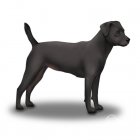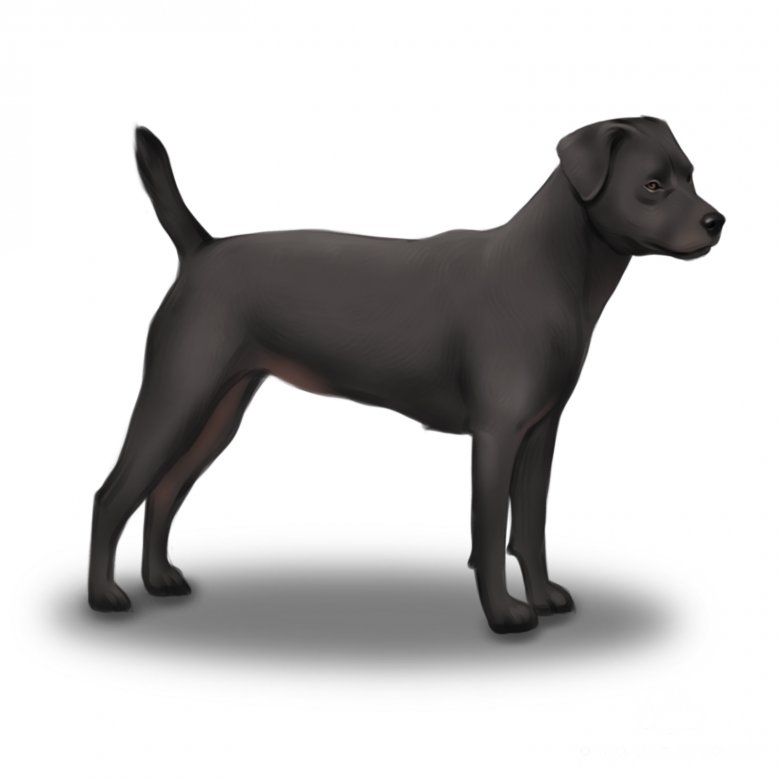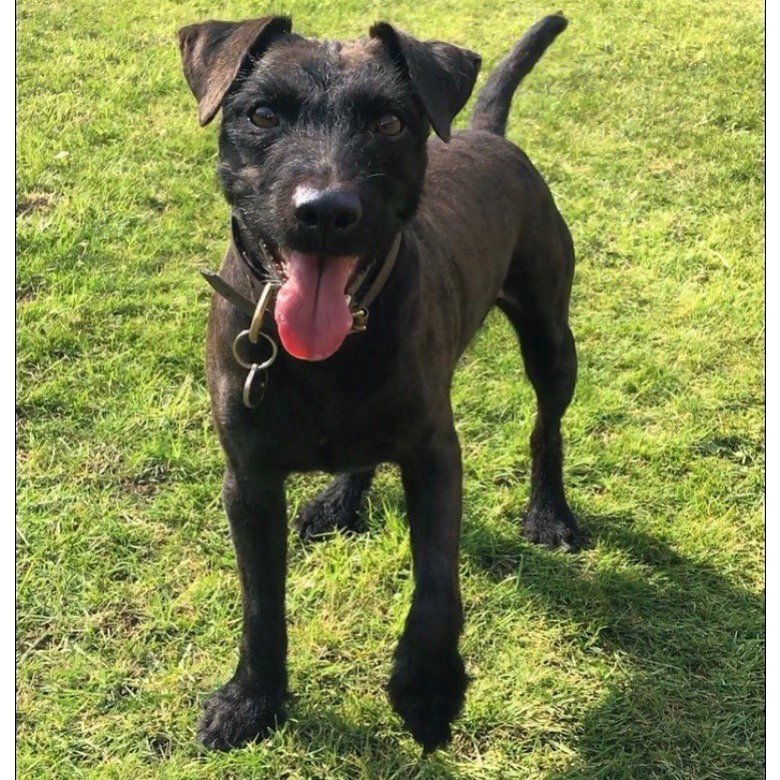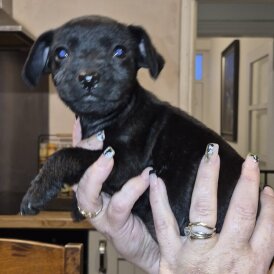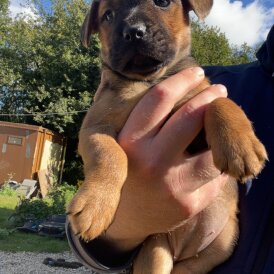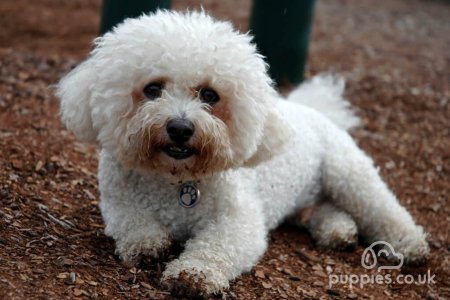History
The Patterdale Terrier, also known as the Black Fell Terrier, is still not a recognised Kennel Club breed. This is despite the fact that it can trace its roots back to the Lake District in the North West of England. Like most members of the terrier group, the Patterdale Terrier was originally bred to hunt. A legendary hunt master, Joe Bowman, is credited with ‘creating’ the breed. Joe was a breeder of Border Terriers and the Patterdale Terrier emerged from the crossing of a Border with a Fell Terrier, also known as a working Lakeland. Despite the rather complex nomenclature, this dog proved to be a hit with fell farmers. The Patterdale Terrier was able to hunt foxes in open country, covering miles in tough hilly terrain and working in the most inhospitable of climates. The small frame and strong sense of smell allowed the Patterdale Terrier to follow prey into the smallest crevice, something that endeared the breed to farmers keen to cull badgers on their land.
Appearance
Since the breed is not officially recognised by the Kennel Club, there is no standard yet set for the way a Patterdale Terrier should look. However, breeders both in the UK and the USA are working hard to establish one. Like other terriers, the Patterdale Terrier has a small head, dark eyes and a short muzzle. Rough, dogs with longer coats and more hair on the face. Whatever the type, the coat is there to offer good protection against the elements and the hilly terrain the original hunters operated in.
How big is the Patterdale Terrier?
The general consensus is that the Patterdale stands between 25 and 40cm at the shoulder and weighs around 5kg.
What colours can I get a Patterdale Terrier puppy?
They come in a variety of colours including black, bronze, red, tan and chocolate.
Temperament
Patterdale Terriers are brave dogs and puppies and have a developed instinct to kill when confronted with small pets. So, beware of leaving them around your other animals.
Am I okay to leave my Patterdale terrier alone?
The Patterdale terrier needs a lot of stimulation, and if you are to leave alone, make sure adequate space is given to allow them to play. Despite this dog’s strong farming and country roots the Patterdale makes an excellent non-sporting pet as he is loyal and quite in the house, providing he gets enough daily exercise.
Can I leave my Patterdale Terrier with small animals?
The Patterdale’s prey drive is possibly higher than that of any other terrier making him particularly popular with farmers and hunting types who see him very much as a working dog. You should therefore be cautious when leaving around small animals.
What are Patterdale Terriers like with children?
With regard to the Patterdale's large prey drive, always keep an eye around children too. Young children may get on their nerves, but providing they are taught well and stimulated enough, they will behave well.
What is the Patterdale Terrier used for today?
With the decline in hunting, the Patterdale Terrier is now mainly a companion dog. But this is not a breed for the couch potato. The ideal owner is an experienced dog handler who enjoys the outdoors. The Patterdale Terrier needs plenty of exercise and excels at sports that require speed, which is why it’s so popular with competitors who take part in agility competitions.
Do Patterdale Terriers make good pets?
For the active owner who takes long walks in open country, the Patterdale Terrier is the ideal companion. Fearlessly loyal and happy to play for hours, the Patterdale Terrier particularly enjoys games which make the best of use of its intelligence. Would-be owners need to be aware that early socialisation is crucial to avoid problems later on life. A good part of the day should be set aside for keeping them occupied with plenty of walks – the more challenging the terrain the better.
Care
What grooming requirements do I need for my Patterdale Terrier dogs and puppies?
The coat will generally fall into one of three categories. Smooth, which as the name suggests, consists of fur that is short and sits close to the body. Broken, where the fur is of a coarser feel, with whiskers on the muzzle and chin. They are considered fairly low maintenance dogs, but a coat brush every now and then and ensuring the toenails of your Patterdale Terrier don't get too long is important
How much exercise do Patterdale Terriers need?
1-2 hours per day will be sufficient, with ensuring that there is plenty space outside for your patterdale to stay entertained. They are considered fairly high need of exercise due to their terrier nature, being inquisitive and cheeky. When you have your Patterdale Terrier puppy, however, make sure you are careful not to over exercise them as they are still growing.
Do Patterdale Terriers suffer from health issues?
This remains a comparatively rare breed, so not much is published about hereditary conditions or general health conditions. Responsible breeders will be aware of any issues and will do their utmost to breed them out. Owners report that the Patterdale Terrier is a healthy breed. The exception is the eyes. Conjunctivitis can be a problem, usually caused by allergies or bacterial and viral infections picked up while out and about. Symptoms can include discharge from the eye; this can be clear or green. The sclera, or whites of the eyes, can be red and the surrounding eye area swollen. It is not a dangerous condition and can be easily treated. Other eyes issues to look out for include cataracts – the clouding of the lens. The good news is that in the event of diagnosis most dogs with cataracts do not need surgery. Generally, cataracts only affect older dogs. Knee problems, which are relatively common throughout the terrier group may also affect the Patterdale Terrier. Known as patellar luxation, the condition can manifest itself in a number of ways. Signs to watch out for include a skipping action, where the dog carries its hind leg for a few steps. It can affect more or more legs. If two legs are affected at the same time, then walking can become difficult and pets affected adopt a crouched action. Owners who suspect that their dog is suffering should visit their vet practice immediately. The vet should be able to grade the problem and assess the likelihood of treatment. Many dogs will not require surgery, but exercise may need to be restricted and a weight management programme put in place. Hydrotherapy has been shown as an effective way of managing this chronic condition. In more severe cases surgery is an option.
Patterdale Terrier Adoptions and Other Organisations
Thank you ever so much to the following organisations for helping to shape this article. https://www.patterdaleterrierrescue.co.uk/ https://animalcareofgloucester.com/client-resources/breed-info/patterdale-terrier/ https://www.dogstrust.org.uk/rehoming/dogs/filters/~228~~~~n~ https://thehappypuppysite.com/patterdale-terrier/






